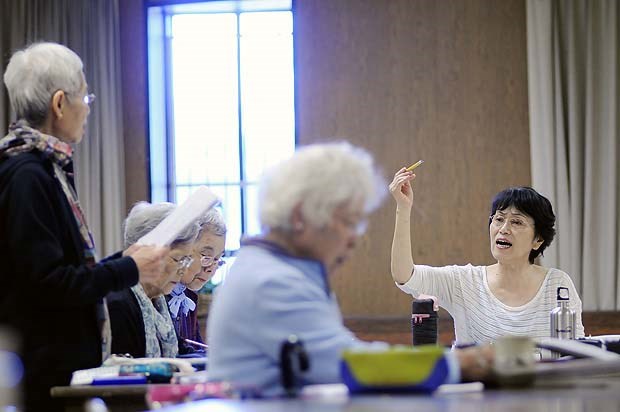Although Strathcona carries a strong image of a working class monoculture, the shadow of a mostly forgotten community still lingers. The blocks between Jackson and Main to the east and west, and Cordova and the waterfront to the south and north were once a landing point for Japanese immigrants seeking a new start in Canada at the turn of the 20th century. This small district within Strathcona was once called Japantown. A few remnants of the lost neighbourhood still exist, such as the Vancouver Buddhist Temple.
Located on 220 Jackson Ave. across from Oppenheimer Park, the three-storey, cream coloured temple stands out from the rest. The building moved across Strathcona, from its original place on 32 Alexander St. in 1906, to several other sites until the group purchased a Methodist church at its current location in 1954. In 1979, the Buddhist temple was built.
Bob Akume, who serves as president for the Vancouver Buddhist Temple and assistant to Reverend Tatsuya Aoki, says that like Strathconas Japanese community, the membership of the temple has also dwindled. What was once a hub for Vancouvers Japanese-Canadians now only has 370 members.
In the last 15 to 20 years, many children who grew up around the temple have chosen to build homes outside of Strathcona, Akume said. Many want the opportunity to raise families and buy homes in newer areas. In Strathcona and other neighbourhoods, housing can be very restricted. A lot of businesses and stores have closed or moved elsewhere as well In a previous generation almost every [member] had some connection with the neighbourhood.
Jodo Shinshu Buddhism is the most practiced sect of Buddhism in Japan as it does not enforce many rules onto individuals. Akume said that a main drawing point for converts is the focus on self-reflection through meditation. Jodo Shinshu is a Buddhism of the family, as the temple is run by the community rather than monks or nuns. Reverend Aoki holds religious services, while an elected board of directors runs takes care of administration.
The decline of Japantown began in 1942, during the Second World War. After the Japanese attack on Pearl Harbor in December 1941, Japanese-Canadians were branded as enemy aliens by the federal government. Any Japanese-Canadians living within 160 kilometres of B.C.s coast were relocated into internment camps in the provinces interior or Alberta.
After the ban was lifted by the government, most went back to Vancouver and the coast, Akume said. Many chose to go back to Strathcona, but it was reduced quite a bit because of racial discrimination, some people chose to return to Japan.
Akumes family was forced from their home in Steveston, just south of Richmond, and chose to move to Lethbridge, Alberta. Families who chose to stay in B.C. were often separated, as men were required to work for the government on railways or labour camps. Akume moved back to Steveston after the ban was lifted in 1952 and resumed high school before studying dentistry at UBC.
Enough members of the temple returned after the war for it to return to life. Akumes wifes family ran a tofu shop just across from Oppenheimer Park, and many Japanese businesses were able to thrive in the neighbourhood until a few decades ago. Today, just over 30 of the temples 370 members are non-Japanese residents of Strathcona and the Downtown Eastside, who have sought solace at the temple. However, Akume said these members can sometimes be transient.
Its a shifting population, and the duration of attendance is limited, Akume said. In two or three years many stop attending, and we dont know the reason.
The temporary status of outside members in some ways reflects Strathconas population people are drawn to the temple and to Buddhism when they need it, but will leave when they no longer do. Yet many who were born as members feel a sense of pride and community surrounding the temple.
Greg Chor grew up on the citys East Side and has been a member of the temple since 2007. Chor said that he was drawn towards Buddhism after reading a book by Buddhist author Kenneth Tanaka and found that both the temple and Buddhism have given him an outlook on living life with gratitude.
[The temple] is a place where people can discover themselves, Chor said. Their own views, sense of mindfulness and gratitude. Its accessible to everyone, the door is always open.
The temples philosophy, said Akume, is about finding meaning in the individual. Having large growth in terms of membership isnt in our teachings. Wed like to show people what the temple can offer but its certainly not an aggressive stance we assume.
Drew_McLachlan@hotmail.com
twitter.com/NotDrowzyD



